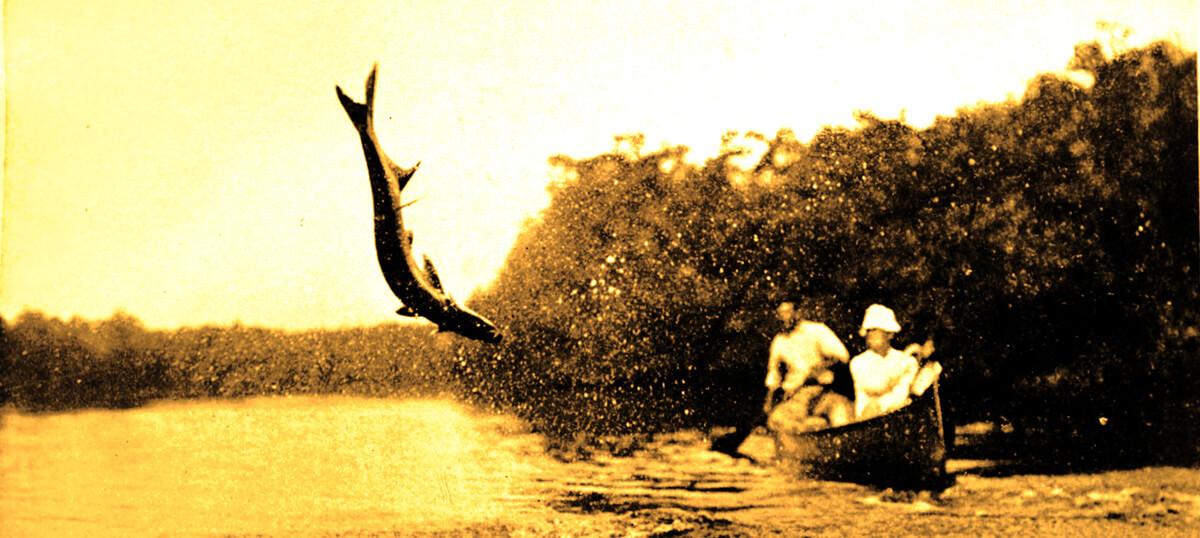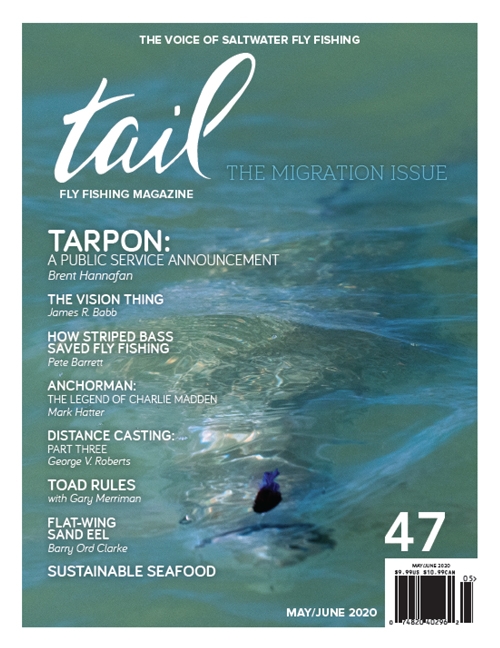A.W. Dimock’s The Book of the Tarpon is a seminal work in the literature of saltwater fly fishing. Published in 1911, it details Dimock’s daring hunt for tarpon along Florida’s southwest coast. In places such as Charlotte Harbor, Pine Island, Boca Grande, and Captiva Pass, Dimock pursued the silver king with fly rod, handline, and harpoon—all from a canoe. The book is nothing short of spellbinding, an adventure story filled with thrilling moments, all wonderfully photographed by Dimock’s son, Julian.
Independence Day
by Ed Mitchell
In those days, Florida was an untamed wilderness, its coastline populated with exotic fish, birds, snakes, and panthers. With his wish to give the reader a sense of the Gulf Coast and his many tales to tell, Dimock devoted little space to his philosophy of saltwater fly fishing. Fortunately for us, he had already done so several years prior.
In January of 1908, the magazine Country Life in America had published an article by Dimock titled “Salt-Water Fly-Fishing.” To my knowledge, this is the first magazine article written on the subject. (Later that year, Dimock would include an expanded version of this piece in his book Florida Enchantments.)
What the article lacks in length it makes up for by giving us insight into Dimock’s feelings about fly fishing in the salt. In the opening paragraphs, Dimock makes a heartfelt confession, one that forces him to reevaluate his connection to the sport.
“Fly-fishing has linked itself with the mountain torrents, swift rivers, and rock-bound lakes of my own North Countrie by ties so sacred that it seems immoral to attempt it in the bays, rivers and passes of the South. Before I could really essay it I had to retire to my room and read aloud the Declaration of Independence. I rejoice now in my victory over superstition, for I find myself a missionary in a benighted land.”
Clearly, Dimock is at war with himself, torn between his affection for freshwater fly fishing and his newfound experiences in the salt. Was fly fishing’s essence so tightly entwined with trout, so “sacred,” that to fly fish in salt water amounted to a sin? It’s a question of enormous gravity, one that would delay the growth of saltwater fly fishing for many years.
The “North Countrie” to which Dimock refers are his home waters of the Catskills, the birthplace of fly fishing for trout in America. There, along with fellow anglers, he established the Peekamoose Fishing Club on the Rondout River in 1880. Dimock doubtless spent many a joyful hour in that clubhouse with his friends, sitting by the fireplace, discussing their love of trout. This helps us to understand Dimock’s dedication to freshwater fly fishing: It undoubtedly was an important part of his life. We also should keep in mind that Dimock was a man of his times. Dimock was highly educated. He attended Phillips Academy in Massachusetts and was a graduate of what is now George Washington University. He was accepted as a member of the Stock Exchange before age 21, and within a few years he controlled the gold market on Wall Street. Dimock was well-read on many subjects, including fly fishing.
Across the Great Pond, Frederick M. Halford, the most well-known fly fishing author of the day, was defining the game for the fly anglers of that era—in the most dogmatic terms. In three books–Floating Flies and How to Dress Them (1886), Dry Fly Fishing in Theory and Practice (1889), and The Dry-Fly Man’s Handbook (1913)–Halford staunchly proclaimed that fly fishing was the art of using dry flies cast upstream. Casting downstream or using wet flies or nymphs was not acceptable sport.
This is not to say Dimock would have found no support for saltwater fly fishing among his contemporaries. James Henshall, who was perhaps the best-known American angler of his time, shared a good bit in common with Dimock. Like Dimock, Henshall had fished in Florida, and he had taken tarpon on a fly several years prior to Dimock. (Henshall recorded his adventures in his book Camping and Cruising in Florida, published in 1884.) Clearly, these two writers, had they met, would have swapped some tall tales. [Did Dimock and Henshall ever meet?]
Apart from Henshall, Dimock might have found a few other members of the fly fishing community who would have offered encouragement–one of whom might have been Theodore Gordon. How is that possible? After all, isn’t Gordon considered the father of dry fly fishing in America? And wasn’t he friends with Halford, having exchanged letters with him over the years? The answer to both questions is yes. However, it would be wrong to pigeonhole Gordon as strictly a trout angler. In truth, Gordon was a generalist at heart, willing to chuck a fly at anything that swam, including bluegills, pickerel, perch, and pike. Gordon had even created a streamer fly he used for striped bass, so he wouldn’t have been dismayed by Dimock’s call to the coast.
Did Dimock and Gordon know of each other? It’s entirely possible. In 1908, when Dimock’s saltwater fly fishing article appeared, Theodore Gordon lived nearby in the Catskills. At that time, Gordon was writing for magazines such as Forest and Stream, which Dimock was apt to have read. It’s also possible that Gordon would have read Country Life in America. Gordon spent a great deal of time fishing the Neversink River, which lies just west of Dimock’s home waters on the Rondout River. Therefore, it’s no great leap to speculate that the two were at least aware of each other (though Gordan’s reclusive nature diminishes the chance that they ever met).
Despite a lack of encouragement, Dimock declares his own Independence Day, concluding unequivocally that the notion of restricting fly fishing to fresh water is nothing more than “superstition,” and that saltwater fly fishing is among his unalienable rights. There is no turning back. In fact, Dimock tells us he is now a “missionary,” ready to tell the world of the glories of saltwater fly fishing.
Unfortunately, Dimock never lived to see the saltwater game take off. In 1908, he had only ten more years to live, and it would be nearly three decades after his passing, with the arrival of such anglers as George Bonbright, George LaBranch, and Joe Brooks, that the game gained even the slightest momentum.
Some will blame the lack of adequate tackle. Clearly that played some role in hindering the development of saltwater fly fishing. When Dimock snapped his fly rod in Florida, his guide had to repair it with a hickory hoe handle. It wouldn’t be until the mid-1930s that decent bamboo rods became widely available, with companies such as Montague, Leonard, and Payne offering models intended for salmon and freshwater bass that could be pressed into service in the salt. Ten years later, Edward vom Hofe & Company advertised a special “De luxe” [check this spelling] Tarpon Fly Rod to celebrate Bonbright’s 136-pound silver king caught in 1933. But the first commercial fly rod designed specifically for salt water wouldn’t arrive until nearly the end of World War II, when Orvis built saltwater fly rods at the urging of Rhode Island angler Harold Gibbs.
The scarcity of saltwater fly fishing literature was also a problem. The first book on the subject didn’t arrive until Joe Brooks’ 1950 Salt Water Fly Fishing. It sold few copies and never went into a second printing. For the first successful saltwater title we would wait more than 20 years for Lefty Kreh’s Fly Fishing in Salt Water.
Magazines did little better. Field & Stream and others were publishing the occasional saltwater article as far back as the ’30s, yet it would be nearly 75 years after Dimock’s death before saltwater fly fishing had its own magazine. That was a critical factor delaying the advancement of the sport. Unlike books, magazines turn out fresh facts and innovative thinking on a monthly basis, and periodicals typically reach a far greater readership.
More than anything else, however, the delay in tackle and literature was due to lack of demand. Despite the urging of forward-thinking men like Dimock and Brooks, the idea of salt water fly fishing sparked no immediate gold rush, no instant congregation of anglers marching seaward. Instead, with few exceptions, fly anglers stayed streamside with their beloved trout.
This reluctance to heed the call to the coast is not that difficult to understand. And it brings us full circle, back to Dimock’s quandary of 1908. Can you accept salt water as a legitimate part of the sport? Fly fishing is steeped in the past, richly laced with customs and ideas so deeply rooted they have become bible. This why fly fishing has always spawned more than its share of purists, anglers who insist on believing that the sport has only one true path.
Today, that question is behind us, long ago put to rest. Salt water is a highly respected and fascinating part of the fly fishing game, offering anglers around the world tremendous sport. If Dimock were alive to see it, he would be ecstatic, proud that salt water has finally gotten the attention it deserves. He would want to examine our wonderful tackle, cast our rods, see our flies, read our books and periodicals, and hear our tales. And yet, even so, Dimock might look around and whisper an aside, telling us his mission may not be over: There are likely anglers still walking among us who have yet to celebrate their own Independence Day.
The End



